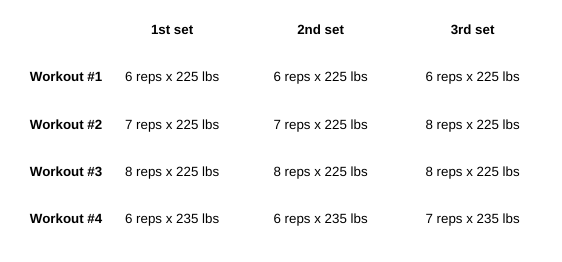
Picture this:
You’re in the middle of a set on dumbbell incline bench.
The program calls for 8 reps and you were able to get up the last one without much of a struggle.
That tells you you’re not lifting heavy enough.
So you think you might need to increase the weight but at the same time, you’re not really sure.
Decisions, decisions.
Struggling to decide is just adding to your workout time.
And you still have cardio to do after this.
Damn.
Well…
Instead of guessing, crossing your fingers, and hoping the next weight you’ve chosen is a good one—
How about a straightforward training method for getting stronger?
One that tells you exactly when to increase the weight?
Say what’s up to the dynamic double progression training method.
Aka the way you’re going to level up and unleash some Incredible Hulk-sized strength and muscle gains.
What is double progression training?
The double progression method is essentially a structured way to apply progressive overload (the act of gradually increasing the amount of weight you lift over time).
Here’s how the double progression method works:
Let’s say you’re focused on building your glutes with a dumbbell exercise like squat.
You have a certain rep range (we’ll use 8-12 as an example).
Once you hit the high end of the range, it’s time for you to go up in weight (a 5-10 pound increase is typical).
With the new weight, you’ll start at the bottom end of your rep range (8).
Once you make it to the top again (12), drop your reps back down, increase the weight, and repeat.
Another way to think about the double progression method is this:
As you work up to the top of your rep range, you’re increasing volume.
That’s the first progression.
The second progression is when you drop down in reps and increase the weight.
So…First progression (increase volume) + Second progression (increase in weight) = Double progression training.
You’re basically getting double the reward out of your strength training.
No matter whether you’re bulking or cutting, the double progression ensures you’ll continue to make progress with your workouts (but always keep in mind you can’t out-work a poor diet!)
Single progression training method (how you’re probably training now)
Most of the training people do is single progression training.
There’s no real process for when to increase the weight or by how much.
You just go based on feel.
It’s the whole, “Well, I think I might need to go up in weight, so I do” approach.
With the single progression method, the number of sets and reps stay the same.
The only thing you change is the weight (hence the name “single” progression).
Using deadlift as an example, here’s what that might look like in workout form:
Single progression training example
- Week#1: 3 sets of 5 reps x 225 lbs
- Week #2: 3 sets of 5 reps x 230 lbs
- Week #3: 3 sets of 5 reps x 235 lbs
Notice how in the example above, the reps and number of sets stayed the same while weight used was the only thing that changed.
Also, you can see that we increased the weight each week.
This is an example of linear progression weightlifting, which happens when you’re able to achieve consistent progress.
If you’re just starting out on your strength training journey, there’s this thing called “newbie gains” you’ll probably be able to take advantage of.
Since you’re new to weightlifting, you won’t have any problem building muscle, strength, or seeing progress during this phase.
But you can only ride that wave for so long.
And like the saying goes: All good things must come to an end.
Eventually, that well starts to dry up and you reach a point where you’d do just about anything to see even the slightest progress in your strength training workouts.
You might have an idea of doubling down and grinding harder.
But let me just say, that mentality doesn’t always work.
I still get like this sometimes in my own workouts.
I’m not getting the result I want so I go harder.
More weight. More reps. More time in the gym.
In my mind, trying harder and doing more should equal better results.
But as I’ve found out on many occasions—
A lot of the time, putting in more effort and going harder actually does the opposite of what we want.
It’s insanely frustrating, I know.
But there’s always a rainbow behind every set of clouds.
And for you, that ray of sunshine is the double progression method.
How do you perform dynamic double progression?
Let’s walk through a double progression exercise example.
We’ll show the chest some love, so let’s say you want to improve your bench press.
Imagine your current workout calls for 3 sets of 8 reps.
But now you’re stuck.
You don’t know if or when you should increase the weight.
Rather than take a stab in the dark, simply apply the double progression method:
- Step 1: Establish your rep range (6-8)
- Step 2: Work to the top of that range using the same weight
- Step 3: Drop the reps, increase the weight, and repeat
Double progression example
Your progression might look something like this:

A couple things to point out:
I would recommend holding off on increasing the weight until you can hit the top of your rep range for all sets during your workout.
In our example above, check out how we hit the top of our rep range on the 3rd set of workout #2.
Instead of increasing the weight for the next workout, you’d stay at the same weight until you’re able to perform all sets at the top end of the range.
A 5-10 pound increase on compound exercises is pretty standard.
But that might not be too realistic for isolation exercises like bicep curls, for example.
If you can, try going up 2.5 lbs at a time or something small like that on those.
At the end of the day, the whole point of the double progression method is to have a systematic way of increasing the weight and continuing to progress with your strength training.
What is the 2 for 2 workout rule?
Thought I’d throw this little weightlifting nugget out there in case you’re looking for even more ways to get stronger.
It’s called the 2 for 2 workout rule.
Similar to the double progression method, the 2 for 2 training protocol also helps you decide when to go up in weight.
Basically, the 2 for 2 rule says that if you can complete 2 or more repetitions above your desired rep range for 2 straight sets, then it’s time to up the weight.
2 for 2 workout rule example
Your program calls for 3 sets of 6 reps of back squats.
If you’re able to get 8 reps two sets in a row, then according to the 2 for 2 rule, that means it’s time to put some more weight on the bar (about 5-10 pounds should be good).
Is double progression training for you?
Don’t sweat it if you’re unsure of when to go up in weight.
Instead of just hoping you make the right decision, simply apply the double progression method.
It gives you a systematic way to progressively overload, which is key to building muscle, realizing strength gains, and breaking through plateaus in the gym.
Here are some key takeaway points:
- Remember to start at the bottom of your rep range. For example, if your rep range is 4-6 reps, you would start at 4. Work your way up to the top of your rep range using the same weight. Once you get to the top, drop the reps, increase the weight, and go through the cycle again.
- Wait to increase the weight until you’re able to hit the top of your rep range for all sets during a given workout.
- Don’t expect to increase the weight on isolation exercises as much as you do with compound movements.

What's up?
I’m Chad, I’m happy you’re here! I’m a certified personal trainer and my goal is to help you form practical, sustainable habits that lead to lifelong fitness results. If you want to lose fat, build muscle, and live a healthier, happier life then you’re right where you need to be. 💪🏾
Free resources
⬇⬇⬇










0 Comments